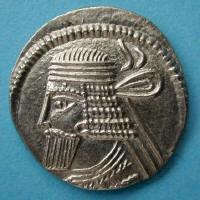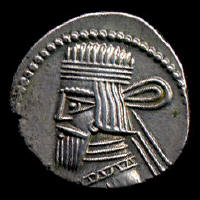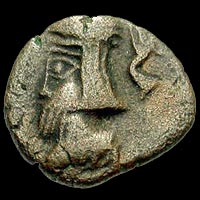Later Parthian Drachms with "Square Beards"
Identifying Look-alike Parthian Drachms
Here we consider as "square beards" those with shapes that are square, rectangular, or tapered but square-cut. The three groups can be immediately separated based on hairstyle and earring of the obverse portrait. The drachms of Vologases I are identified by five distinct waves in the hair, the second group all have straight or nearly straight hair with an earring, and group three drachms have straight hair with no earring.
| Five waves in hair |
Straight hair with earring |
Straight hair, no earring |
 |
 |
 |
Group I: Hair has five distinct waves
Group II: Hair is straight or nearly so with an earring
Group III: Hair is straight or nearly so with no earring
Group I: Differentiating the Drachms of
Vologases I (c. A.D. 51 - 88)
There are two types within this group, both characterized by a tapering but square cut beard and hair with five distinct waves. Both types have a wart on the forehead and an earring.
- Vologases I (type 70) drachms have no inscription nor monogram behind the obverse head
- Vologases I (type 71) drachms are identified by a two-letter Parthian inscription [ wl ] or a monogram behind the obverse head
- Exception: the portrait on subtype 71.4 has a pointed beard, hair in three waves, no wart and no earring; identification of these coins is discussed on the "Pointed Beards" page
Group II: Differentiating the Drachms of
Artabanus II (c. A.D. 10 - 38)
Gotarzes II (c. A.D. 40 - 51) and
Artabanus III (c. A.D. 80 - 90)
Case 0. Debased silver drachms
Case 1. Differences between types 63 and 65
Case 2. Differences between types 63 and 66
Case 3. Differences between types 63 and 74
Case 4. Differences between types 65 and 66
Case 5. Differences between types 65 and 74
Case 6. Differences between types 66 and 74
- Case 0 (debased silver drachms) are distinguished by their reverse design
- If reverse of debased silver drachm has the king enthroned left receiving diadem from kneeling man, it is Artabanus II (type 62.6-11)
- Debased silver drachms with the seated archer reverse are attributed to Artabanus II (type 63.7-13)
- Crescent or star-over-crescent appears in front of bust on type 63.11-13
In An Introduction to the Coinage of Parthia (1980), Sellwood notes the close resemblance between the drachms of types 63, 65, 66 and 74. There are some very obvious and some not-so-obvious differences between these drachms. Since we are dealing with four types, we have to consider the following permutations:
- CASE 1 (Differences between types 63 and 65)
- The most obvious difference between Artabanus II type 63 and Gotarzes II type 65 is the presence of a horizontal line on brow of type 65. However, on very worn examples of type 65, this could easily be absent making the identification somewhat difficult. Those who have seen many examples of both types can still see the subtle differences between the engraving styles of the obverse portraits even when the horizontal line on brow (representing a wart) of type 65 is worn away.
- While the king's beard on type 65 is always visibly long, many earlier examples of type 63 show the king with a medium-length rectangular beard which gradually becomes longer on later examples. Some examples of type 65 (type 65.34 and type 65.35) show the king's hair in three distinct waves while Artabanus II's hair on type 63 drachms is almost always straight.
- CASE 2 (Differences between types 63 and 66)
- While the obverses of these two types display the same differences as Case 1, the reverse inscription of Gotarzes II type 66 is quite distinct. If you refer to Sellwood's drawing of type 66 , you will notice that the reverse of type 66 bears the personal name of Gotarzes given as ΓΩΤΕΡΖΗΣ in the left-most vertical line of the inscription. (Note the difference from spelling ΓΩΤΑΡΖΟΥ used on the tetradrachm.) You will also notice the name of Gotarzes' father (step-father in reality) given as ΑΡΤΑΒΑΝΟΝ, with very degenerated characters, below Gotarzes' personal name. In fact, the whole of the reverse inscription of type 66 reads: The King of Kings, Arsaces, having been called the Son of Artabanus, Gotarzes
- CASE 3 (Differences between types 63 and 74): Here you need all your wits and experience with the late Parthian drachms to see the subtle differences. In fact, before Sellwood's identification of type 74 as drachms of Artabanus III, every single previous numismatist had grouped them either with drachms of Artabanus II or Gotarzes II. Only the correct sequence of die-engravers placed type 74 much later than type 63 and type 65.
- If you look carefully at a few examples of type 63 and type 74, you will see the hands of two different engravers at work for the reverses of type 63 [engravers A and B according to Sellwood, "A Die-Engraver Sequence for Later Parthian Drachms", Numismatic (1967), pp. 13-28 and plates I and II] and a single different engraver for type 74 (engraver H). The engraver for type 74 did not start before type 73 drachms of Pacorus II; he was responsible for some of the dies of type 73 (Pacorus II, beardless bust), all of type 74 (Artabanus III) and type 77 (Pacorus II, bearded with tiara), and some of type 78 of Vologases III.
- There are subtle differences between the obverse portraits of type 63 and type 74 drachms which is due solely to the hands of two different die-cutters.
- CASE 4 (Differences between types 65 and 66)
- The only difference between type 65 and type 66 is the reverse inscription of type 66 which bears the personal name of Gotarzes, etc. as referred to above. Other features remain exactly the same on both types.
- CASE 5 (Differences between types 65 and 74)
- The obverse of type 65 shows a horizontal line on the king's brow while type 74 lacks this.
- What was said above about the distinguishing features between type 63 and type 74 drachms (Case 3) also holds true for differentiating type 65 and type 74. The engravers responsible for type 65 (engravers B and C) did not cut dies for type 74 drachms of Artabanus III. Although both obverse busts and reverse inscriptions of these two types are quite similar (specially the reverses), again certain minor differences separates the two and anyone with some experience of the coins would notice these (see Sellwood's article for more details about the differences in engraving styles of engravers B, C, and H).
- CASE 6 (Differences between types 66 and 74)
- Differentiate type 66 from type 74 by inspecting the reverse inscriptions; type 66 has the personal name of Gotarzes, etc. as stated in Case 2 above.
- Look for the horizontal line on the brow of the king on type 66; this is absent on type 74.
Group III: Drachms of Artabanus II
(c. A.D. 10 - 38)
with no earring
- Artabanus II (type 61.9) obverse has a tapered but square-cut beard and no earring
- Artabanus II (type 62.12) obverse has a rectangular beard and no earring, with Nike to left and right of the bust. This is a copper drachm
- The other drachms of Artabanus II with no earring have pointed beards; they are discussed on the "Pointed Beards" page

